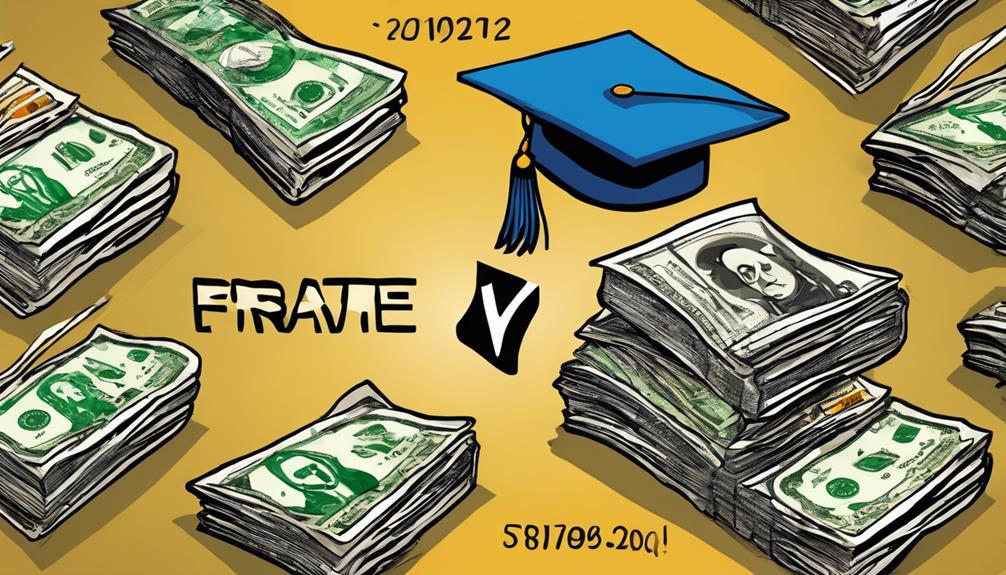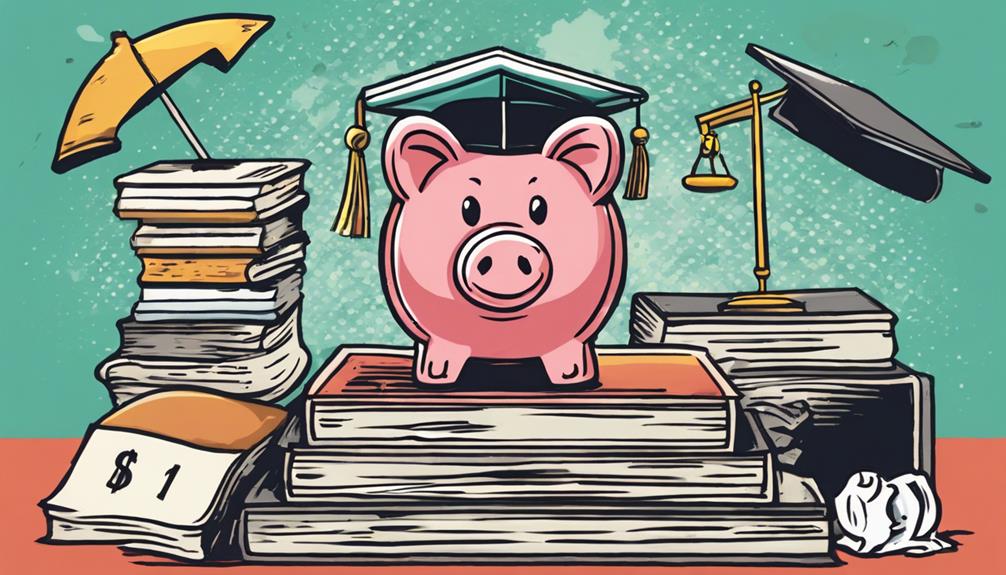When deciding on student loans, federal options provided by the U.S. Department of Education offer fixed rates, borrower protections, and repayment flexibility. These loans are tailored for education-related expenses and come with specific eligibility criteria. In contrast, private loans offered by financial institutions may have variable rates and stricter terms, potentially leading to fluctuating payments. Understanding the differences in interest rates, terms, and borrower protections is key to making a wise decision for your education and finances. Further exploration of federal vs. private student loans can provide valuable insights for your choice.
Key Takeaways
- Federal loans offer fixed rates, borrower protections, and flexible repayment options.
- Private loans have variable rates, fees, and may require a co-signer for approval.
- Federal loans are provided by the U.S. Department of Education with set terms.
- Private loans come from banks, credit unions, and private lenders with varying terms.
- Responsible borrowing involves researching options, prioritizing federal loans, and borrowing only what's necessary.
Federal Student Loans Overview
When considering financial aid options for education, a significant aspect to understand is the overview of federal student loans offered by the U.S. Department of Education. These loans provide a key source of funding for students pursuing higher education, with rates and terms set by law. Federal student loans can be used for various education-related expenses, offering flexibility and support to borrowers.
It's worth mentioning that there are three main types of federal student loans available: Direct Subsidized Loans, Direct Unsubsidized Loans, and Direct PLUS Loans. Each type has specific eligibility criteria and features tailored to different student needs. Understanding the basics of federal student loans is essential in making informed decisions regarding financing education.
Types of Federal Student Loans

Exploring the various options available, what distinguishes the types of federal student loans offered by the U.S. Department of Education? The U.S. Department of Education provides three main types of federal student loans: Direct Subsidized Loans, Direct Unsubsidized Loans, and Direct PLUS Loans. Below is a table summarizing the key features of each type:
| Loan Type | Eligibility | Interest Payment Responsibility | Annual Borrowing Limits | Additional Information |
|---|---|---|---|---|
| Direct Subsidized | Undergraduates with financial need | U.S. Department of Education pays interest while in school | Yes | Specific eligibility criteria apply |
| Direct Unsubsidized | Available for all students | Students responsible for interest payments | Yes | Annual limits set by school, financial experts recommend maximizing |
| Direct PLUS | Parents and graduate/professional students | Higher interest rates, credit check required | Cost of attendance | Specific eligibility criteria apply |
Private Student Loans Overview

Understanding the differences between federal student loans and private student loans is essential for making informed decisions about financing higher education.
Private student loans are offered by banks, credit unions, and other private lenders as an additional option after exhausting federal loan options. These loans can cover various education-related expenses but may require a co-signer for approval.
Interest rates and terms for private student loans are set by the lender, leading to variations among different lenders. Unlike federal loans, private loans often have variable interest rates and fees, including origination fees and application fees.
It is vital for students to compare offers carefully before accepting a private loan and to fully understand all associated fees and terms to make a responsible borrowing decision.
Comparison of Interest Rates

Consideration of interest rates is essential when evaluating the options between federal and private student loans for financing higher education. Federal student loans typically offer fixed interest rates set by the government, providing stability and predictability for borrowers. On the other hand, private student loans may have fixed or variable rates determined by the lender, potentially leading to fluctuating payments. Below is a comparison table showcasing the key differences in interest rates between federal and private student loans:
| Loan Type | Federal Student Loans | Private Student Loans |
|---|---|---|
| Interest Rate Type | Fixed | Fixed or Variable |
| Rate Determination | Government-set | Lender-set |
| Rate Stability | Stable | May fluctuate |
| Borrower Protections | Various repayment plans and forgiveness options | Fewer borrower protections |
This table highlights the importance of understanding interest rate structures when deciding between federal and private student loans.
Responsible Borrowing Tips

To make informed decisions when financing higher education, it is imperative to adhere to responsible borrowing practices, ensuring financial stability throughout the loan repayment process. When considering borrowing for education, start by exhaustively researching and understanding different loan options available. Prioritize federal loans due to their fixed interest rates, flexible repayment plans, and borrower protections.
Complete the Free Application for Federal Student Aid (FAFSA) to determine eligibility for federal loans. After maximizing federal aid, cautiously explore private loan options, comparing terms, interest rates, and fees diligently. Aim to borrow only what is necessary to cover educational costs and consider future repayment obligations.
Frequently Asked Questions
Can Federal Student Loans Be Used for Living Expenses?
Yes, federal student loans can be used for living expenses, including housing, transportation, and personal costs, in addition to educational expenses. However, it is important to borrow responsibly and understand all associated terms and conditions.
Are Private Student Loans Eligible for Loan Forgiveness Programs?
Private student loans are generally not eligible for federal loan forgiveness programs. These forgiveness programs, such as Public Service Loan Forgiveness, typically apply to federal loans. Private lenders may offer their own repayment assistance programs, but they differ from federal options.
Do Credit Unions Offer Student Loans With Cosigner Release Options?
Yes, credit unions may offer student loans with cosigner release options. These loans can provide flexibility for borrowers as they may allow for the eventual removal of the cosigner from the loan agreement, subject to specific terms and conditions.
Is There a Maximum Number of Private Loans a Student Can Take?
There is no specific maximum number of private loans a student can take. However, it is essential to borrow responsibly and consider overall debt load. Research loan options, compare terms, and prioritize federal loans before turning to private lenders.
Can Nonprofit Loans Be Consolidated With Federal Loans for Repayment?
Nonprofit loans, such as NC Student Assist Loan, cannot be consolidated with federal loans for repayment. Consolidation options typically pertain to federal loans exclusively. It is important to explore available repayment options and eligibility criteria for each loan type.
Conclusion
In the vast landscape of student loans, the choice between federal and private options can seem overwhelming. By understanding the nuances of each type of loan and considering factors such as interest rates and repayment terms, borrowers can make a well-informed decision that aligns with their financial goals.
Remember, choosing the right loan is like finding a needle in a haystack – but with careful consideration, the path to financing your education can be clearer than ever. When considering your loan options, it’s important to carefully evaluate interest rates, repayment terms, and any potential hidden fees. By doing so, you can ensure that you’re choosing a loan that aligns with your financial goals and sets you up for success in the future. In addition to finding the right loan, it’s also important to focus on developing soft skills for every job, such as communication, teamwork, and problem-solving abilities, which will be essential for navigating the professional world after completing your education.









